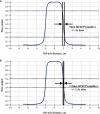Potential Clinical Significance of Overall Targeting Accuracy and Motion Management in the Treatment of Tumors That Move With Respiration: Lessons Learnt From a Quarter Century of Stereotactic Body Radiotherapy From Dose Response Models
- PMID: 33634020
- PMCID: PMC7900559
- DOI: 10.3389/fonc.2020.591430
Potential Clinical Significance of Overall Targeting Accuracy and Motion Management in the Treatment of Tumors That Move With Respiration: Lessons Learnt From a Quarter Century of Stereotactic Body Radiotherapy From Dose Response Models
Abstract
Objective: To determine the long-term normal tissue complication probability with stereotactic body radiation therapy (SBRT) treatments for targets that move with respiration and its relation with the type of respiratory motion management (tracking vs. compression or gating).
Methods: A PubMed search was performed for identifying literature regarding dose, volume, fractionation, and toxicity (grade 3 or higher) for SBRT treatments for tumors which move with respiration. From the identified papers logistic or probit dose-response models were fitted to the data using the maximum-likelihood technique and confidence intervals were based on the profile-likelihood method in the dose-volume histogram (DVH) Evaluator.
Results: Pooled logistic and probit models for grade 3 or higher toxicity for aorta, chest wall, duodenum, and small bowel suggest a significant difference when live motion tracking was used for targeting tumors with move with respiration which was on the average 10 times lower, in the high dose range.
Conclusion: Live respiratory motion management appears to have a better toxicity outcome when treating targets which move with respiration with very steep peripheral dose gradients. This analysis is however limited by sparsity of rigorous data due to poor reporting in the literature.
Keywords: dose response; normal tissue complication probability; radiosurgery; stereotactic body radiation therapy; tracking.
Copyright © 2021 Mahadevan, Emami, Grimm, Kleinberg, Redmond, Welsh, Rostock, Kemmerer, Forster, Stanford, Shah, Asbell, LaCouture, Scofield, Butterwick, Xue, Muacevic and Adler.
Conflict of interest statement
JG reports grants from Accuray and NovoCure, outside the submitted work. JG also has a patent DVH Evaluator issued. JA reports conflicts from Accuray, Varian, Zap Surgical, outside the submitted work. AM reports conflicts from Accuray and Varian outside of this submitted work. The remaining authors declare that the research was conducted in the absence of any commercial or financial relationships that could be construed as a potential conflict of interest.
Figures





References
-
- Leksell L. The stereotaxic method and radiosurgery of the brain. Acta Chir Scand (1951) 102(4):316–9. - PubMed
-
- Leksell L. Sterotaxic radiosurgery in trigeminal neuralgia. Acta Chir Scand (1971) 137(4):311–4. - PubMed
-
- Betti OO, Derechinsky YE. Irradiations stereotaxiques multifaisceaux. Neurochirurgie (1982) 28:55–6 Available at: https://pascal-francis.inist.fr/vibad/index.php?action=getRecordDetail&i...
Publication types
LinkOut - more resources
Full Text Sources
Other Literature Sources

